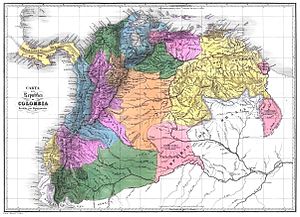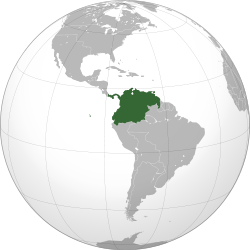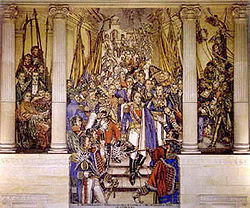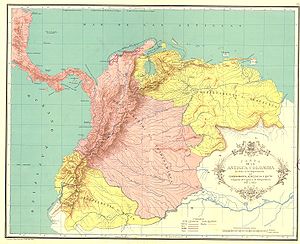- Gran Colombia
-
Republic of Colombia
República de Colombia← 
1819–1831  →
→
 →
→
 →
→

Last flag of Gran Colombia first coat of arms Gran Colombia Capital Santa Fe de Bogotá Language(s) Spanish Religion Roman Catholic Government Republic Presidents - (1819-1830) Simón Bolívar - (1830) Domingo Caycedo - (1830-1831) Joaquín Mosquera - (1831) Domingo Caycedo Vice Presidents - (1819-1820) Francisco Antonio Zea - (1820-1821) Juan Germán Roscio - (1821) Antonio Nariño y Álvarez - (1821) José María del Castillo - (1821-1827) Francisco de Paula Santander - (1830-1831) Domingo Caycedo Legislature Congress - Upper Chamber Senate - Lower Chamber Chamber of Representatives History - Established December 17[1] 1819 - Constitution of Cúcuta August 30, 1821 - Colombia – Peru War 1828-1829 - Disestablished November 19, 1831 Today part of  Colombia
Colombia
 Brazil
Brazil
 Ecuador
Ecuador
 Guyana
Guyana
 Panama
Panama
 Peru
Peru
 Venezuela
VenezuelaGran Colombia (Spanish pronunciation: [ˈɡɾaŋ koˈlombja], Great Colombia) is a name used today for the state that encompassed much of northern South America and part of southern Central America from 1819 to 1831. This short-lived republic included the territories of present-day Colombia, Venezuela, Ecuador, Panama, northern Peru and northwest Brazil. The first three were the successor states to Gran Colombia at its dissolution. Panama seceded from Colombia in 1903. Since Gran Colombia's territory corresponded more or less to the original jurisdiction of the former Viceroyalty of New Granada, it also claimed the Caribbean coast of Costa Rica and Nicaragua, the Mosquito Coast, and Guayana Esequiba in Guyana.
Its existence was marked by a struggle between those who supported a centralized government with a strong presidency and those who supported a decentralized, federal form of government. At the same time, another political division emerged between those who supported the Constitution of Cúcuta and two groups who sought to do away with the Constitution, either in favor of breaking up the nation into smaller republics or maintaining the union but creating an even stronger presidency. The faction that favored constitutional rule coalesced around Vice-President Francisco de Paula Santander, while those who supported the creation of a stronger presidency were led by President Simón Bolívar. The two men had been allies in the war against Spanish rule, but by 1825, their differences had become public and were an important part of the political instability from that year onward.
Contents
Origin of the name
The official name of the country at the time was the Republic of Colombia.[2] Historians have adopted the term Gran Colombia to distinguish this republic from the present-day Republic of Colombia, which began using the name in 1863, although many use Colombia where confusion would not arise.[3]
The name Colombia comes from the Spanish version of the eighteenth-century New Latin word Columbia, itself based on the name of Christopher Columbus (Cristoforo Colombo in Italian, Cristóbal Colón in Spanish, and Cristóvão Colombo in Portuguese). It was the term preferred by the revolutionary Francisco de Miranda as a reference to the New World, especially to all American territories and colonies under Spanish rule. He used an improvised, quasi-Greek adjectival version of the name, Colombeia, meaning "papers and things relating to Colombia", as the title of his archive of his revolutionary activities.[4] Bolívar and other Spanish American revolutionaries also used the word Colombia in the continental sense. The establishment of a nation with the name Colombia by the 1819 Congress of Angostura gave the term a specific geographic and political reference.
Geography
The Republic of Gran Colombia comprised more or less the former territories of the Viceroyalty of New Granada, which it claimed under the legal principle of uti possidetis. It united the territories of the former Second Republic of Venezuela, the United Provinces of New Granada and the Presidency of Quito (which was still under Spanish rule).
Government
Before a new constitution could be written by the Congress of Cúcuta, the Congress of Angostura appointed Bolívar and Santander president and vice-president, respectively. Under the Constitution of Cúcuta, the country was divided into twelve departments governed by an intendant. Departments were further divided into thirty-six provinces headed by a governor, who had overlapping powers with the intendants. Military affairs at the department level were overseen by a commandant general, who could also be the intendant. All three offices were appointed by the central government. The central government, which temporarily was to reside in Bogotá, consisted of a presidency, a bicameral congress and a high court (the Alta Corte). The president was the head of the executive branch of both the central and local governments. The president could be granted extraordinary powers in military fronts, such as the area that became Ecuador. The vice-president assumed the presidency in case of the absence, death, demotion, or illness of the president. Since President Bolívar was absent from Gran Colombia for the early years of its existence, executive power was wielded by the vice-president, Santander. The vote was given to persons who owned 100 pesos in landed property or had an equivalent income from a profession. Elections were indirect.[5][6]
History
Since the new nation was quickly proclaimed after Bolívar's unexpected victory in New Granada, its government was temporarily set up as a federal republic, made up of three departments headed by a vice-president and with capitals in the cities of Bogotá (Cundinamarca Department), Caracas (Venezuela Department), and Quito (Quito Department).[7] In that year, none of the provinces of Quito, nor many in Venezuela and New Granada, were free yet.
The Constitution of Cúcuta was drafted in 1821 at the Congress of Cúcuta, establishing the republic's capital in Bogotá. Bolívar and Santander were elected as the nation's president and vice-president. A great degree of centralization was established by the assembly at Cúcuta, since several New Granadan and Venezuelan deputies of the Congress who formerly had been ardent federalists now came to believe that centralism was necessary in order to successfully manage the war against the royalists. To break up regionalist tendencies and to set up efficient central control of local administration, a new territorial division was implemented in 1824. The departments of Venezuela, Cundinamarca and Quito were split into smaller departments, each governed by an intendant appointed by the central government, with the same powers that Bourbon intendants had.[8] Realizing that not all of the provinces were represented at Cúcuta because many areas of the nation remained in royalist hands, the congress called for a new constitutional convention to meet in ten years.
In its first years, Gran Colombia helped other provinces still at war with Spain to become independent: all of Venezuela except Puerto Cabello were liberated at the Battle of Carabobo, Panama joined the federation in November 1821, and the provinces of Pasto, Guayaquil and Quito in 1822. The Gran Colombian army later consolidated the independence of Peru in 1824. Bolívar and Santander were re-elected in 1826.
Federalists and separatists
 Map of Gran Colombia showing the 12 departments created in 1824 and territories disputed with neighboring countries
Map of Gran Colombia showing the 12 departments created in 1824 and territories disputed with neighboring countries
As the war against Spain came to an end in the mid-1820s, federalist and regionalist sentiments that had been suppressed for the sake of the war arose once again. There were calls for a modification of the political division, and related economic and commercial disputes between regions reappeared. Ecuador had important economic and political grievances. Since the end of the eighteenth century, its textile industry had suffered because cheaper textiles were being imported. After independence, Gran Colombia adopted a low-tariff policy, which benefited agricultural regions such as Venezuela. Moreover, from 1820 to 1825, the area was ruled directly by Bolívar because of the extraordinary powers granted to him. His top priority was the war in Peru against the royalists, not solving Ecuador's economic problems. Having been incorporated later into Gran Colombia, Ecuador was also underrepresented in all branches of the central government, and Ecuadorians had little opportunity to rise to command positions in the Gran Colombian army. Even local political offices were often staffed by Venezuelans and New Granadans. No outright separatist movement emerged in Ecuador, but these problems were never resolved in the ten-year existence of the nation.[9]
The strongest calls for a federal arrangement came from Venezuela, where there was strong federalist sentiment among the region's liberals, many of whom had not fought in the war of independence but had supported Spanish liberalism in the previous decade and who now allied themselves with the conservative Commandant General of the Department of Venezuela, José Antonio Páez, against the central government.[10] In 1826, Venezuela came close to seceding from Gran Colombia. That year, Congress began impeachment proceedings against Páez, who resigned his post on April 28 but reassumed it two days later in defiance of the central government. Support for Páez and his revolt—which came to be known as the Cosiata (the "insignificant thing" in colloquial regional Spanish) in Venezuelan history—spread throughout Venezuela, aided by the fact that it did not explicitly stand for anything, except defiance to the central government. Nevertheless, the support Páez received from across the Venezuelan political spectrum posed a serious threat to the unity of the country. In July and August, the municipal government of Guayaquil and a junta in Quito issued declarations of support for Páez's actions. Bolívar, for his part, used the developments to promote the conservative constitution he had just written for Bolivia, which found support among conservative Ecuadorians and the Venezuelan military officialdom, but was generally met with indifference or outright hostility among other sectors of society and, most importantly for future political developments, by Vice-President Santander himself. Two assemblies met in Venezuela by November to discuss the future of the region, but no formal independence was declared at either. That same month, skirmishes broke out between the supporters of Páez and Bolívar in the east and south of Venezuela. By the end of the year, Bolívar was in Maracaibo preparing to march into Venezuela with an army, if necessary. Ultimately, political compromises prevented this. In January, Bolívar offered the rebellious Venezuelans a general amnesty and the promise to convene a new constitutional assembly before the ten-year period established by the Constitution of Cúcuta, and Páez backed down and recognized Bolívar's authority. The reforms, however, never fully satisfied the different political factions in Gran Colombia, and no permanent consolidation was achieved. The instability of the state's structure was now apparent to all.[11]
In 1828, the new constitutional assembly, the Convention of Ocaña, began its sessions. At its opening, Bolívar again proposed a new constitution based on the Bolivian one, but this suggestion continued to be unpopular. The convention fell apart when pro-Bolívar delegates walked out rather than sign a federalist constitution. After this failure, Bolívar appointed himself dictator, but failed to hold the nation together. As the collapse of the nation became evident in 1830, Bolívar resigned from the presidency. Internal political strife between the different regions intensified even as General Rafael Urdaneta temporarily took power in Bogotá, attempting to use his authority to ostensibly restore order, but actually hoping to convince Bolívar to return to the presidency and the nation to accept him. The federation finally dissolved in the closing months of 1830 and was formally abolished in 1831. Venezuela, Ecuador and New Granada came to exist as independent states.
War with Peru
Main article: Gran Colombia-Peru WarAftermath
The dissolution of Gran Colombia represented the failure of Bolívar's vision. The former Department of Cundinamarca (as established in 1819 at Angostura) became a new country, the Republic of New Granada. In 1863, New Granada changed its name officially to United States of Colombia, and in 1886, adopted its present day name: the Republic of Colombia. Panama, which voluntarily became part of Gran Colombia in 1821, remained a department of the Republic of Colombia until 1903, when in great part as a consequence of the Thousand Days War of 1899–1902,[12] it became independent with the backing of the United States.
With the exception of Panama (which, as mentioned, achieved independence seven decades later), the countries that were created have similar flags, reminiscent of the flag of Gran Colombia:
Contemporary state flags of the nations that were born after the dissolution of Gran Colombia 


Colombia Ecuador Venezuela (See United Provinces of Central America, Nordic countries, and Arab nationalism for more examples of regions whose nations possess similar flags because of historical connections.)
See also
- Federal Republic of Central America - another post-independence state on the American continent that underwent a similar fate
- Peru-Bolivian Confederation
- Flag of Gran Colombia
References
- ^ Bethell, Leslie (1985). The Cambridge History of Latin America. Cambridge University Press. p. 141. ISBN 9780521232241. http://books.google.com/books?id=0QghsDsSCB4C&pg=PA141. Retrieved 6 September 2011.
- ^ "Gran Colombia". Encyclopædia Britannica. 6 June 2007. http://www.britannica.com/eb/article-9037644.
- ^ Bushnell, The Santander Regime, 12. Bushnell uses both "Colombia" and "Gran Colombia."
- ^ Miranda, Francisco de; Josefina Rodríguez de Alonso and José Luis Salcedo-Bastardo (1978). Colombeia: Primera parte: Miranda, súbdito español, 1750-1780. 1. Caracas: Ediciones de la Presidencia de la República. pp. 8–9. ISBN 9788449951633
- ^ Bushnell, The Santander Regime, ii, 18-21.
- ^ Gibson, The Constitutions of Colombia, 37-40.
- ^ Bushnell, The Santander Regime, 10-13.
- ^ Bushnell, The Santander Regime, 14-21.
- ^ Bushnell, The Santander Regime, 310-317
- ^ Bushnell, The Santander Regime, 287-305.
- ^ Bushnell, The Santander Regime, 325-335, 343-345.
- ^ Arauz, Celestino A; Carlos Manuel Gasteazoro and Armando Muñoz Pinzón (1980). La Historia de Panamá en sus textos. Textos universitarios: Historia (Panamá). 1. Panama: Editorial Universitaria.
Bibliography
- Bushnell, David (1970). The Santander Regime in Gran Colombia. Westport, CT: Greenwood Press. ISBN 0837129818. OCLC 258393.
- Gibson, William Marion (1948). The Constitutions of Colombia. Durham, NC: Duke University Press. OCLC 3118881.
- Lynch, John (2006). Simón Bolívar: A Life. New Haven and London: Yale University Press. ISBN 0-300-11062-6.
External links
- "Gran Colombia," Flags of The World
History of South America Sovereign states Dependencies and
other territoriesCategories:- Former republics
- Former countries in South America
- States and territories established in 1819
- States and territories disestablished in 1831
- Gran Colombia
- 1831 disestablishments
- History of South America
- History of Colombia
- History of Ecuador
- History of Panama
- History of Venezuela
- Spanish American wars of independence
- 19th century in Colombia
- Irredentism
Wikimedia Foundation. 2010.




